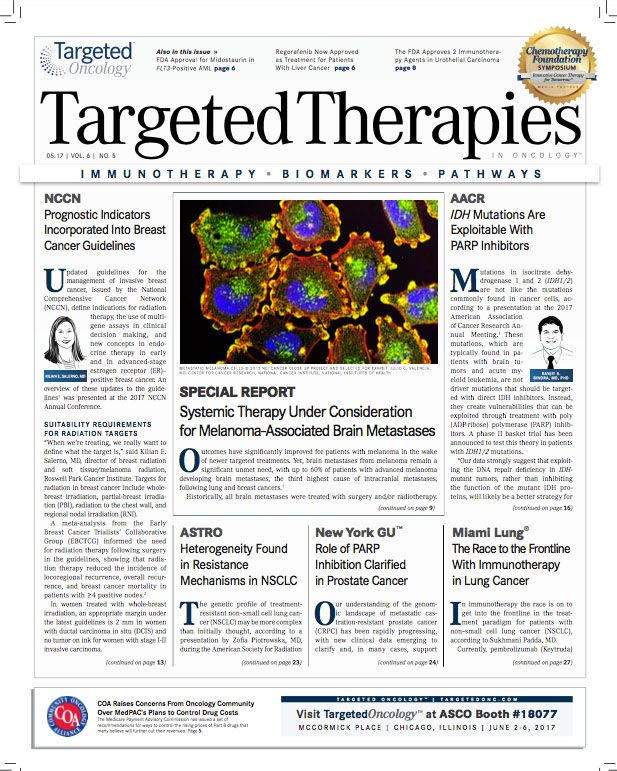Heterogeneity Found in Resistance Mechanisms in NSCLC
The genetic profile of treatment-resistant non-small cell lung cancer may be more complex than initially thought, according to a presentation by Zofia Piotrowska, MD.
Zofia Piotrowska, MD
The genetic profile of treatment-resistant non-small cell lung cancer (NSCLC) may be more complex than initially thought, according to a presentation by Zofia Piotrowska, MD, during the American Society for Radiation Oncology’s 2017 Multidisciplinary Thoracic Cancers Symposium. The study results showed that resistance mutations frequently varied between biopsies in patients with NSCLC who acquired resistance from treatment with an EGFR-targeted therapy.
Part of the problem with assessing patients with NSCLC for targeted therapies is that they may become resistant to certain therapies over time or their disease may progress in a way that could entirely change the course of treatment. Many patients with NSCLC have a mutation on theEGFRgene, which accounts for 15% of all lung adenocarcinomas, and will undergo therapy using tyrosine kinase inhibitors (TKIs) to combat this.
“EGFRmutations are the most common of targetable gene alterations seen in NSCLC, and for patients withEGFR-mutant cancer, EGFR TKIs are standard first-line therapy. Although these drugs initially yield high responses, resistance typically develops after about 9 to 13 months of treatment,” explained Piotrowska, a thoracic oncologist at Massachusetts General Hospital Cancer Center.
Piotrowska led a retrospective analysis of 221 patients with advancedEGFR-mutant NSCLC seen at Massachusetts General Hospital between 2008 and 2016. For each patient, the investigators collected data for all biopsies obtained after resistance, including results of clinical molecular testing, treatment history, and biopsy complications. Overall, 61% of patients were T790M-positive, which is the most common resistance mutation noted, having been found in 50% to 60% of all patients who progress on their initial EGFR TKI. The second most common resistance mechanism wasMETamplification, which was found in 5% of the patients. Eighteen percent wereEGFR-mutation positive. However, 19% of patients harbored more than 1 resistance mechanism.
Among the 83 patients with 2 postresistance biopsies, 49% had variations in the resistance mechanisms identified between their first and second biopsies, including 20% of patients who “lost” the T790M mechanism and 11% who “gained” it. Of the 17 patients who lost the T790M resistance mutation, 3 had a new resistance mechanism noted upon their second postresistance biopsy, including 1 acquiredBRAFmutation and 2 patients withMETamplification.
“The dominant drivers of resistance can fluctuate over time,” Piotrowska commented. This presents a challenge for oncologists, because often in practice, patients rarely undergo further biopsies during their treatment and are commonly categorized as positive or negative for a particular resistance mechanism based on a single biopsy and timepoint. The investigators concluded that a binary positive/negative classification may underestimate the heterogeneity of resistant cancers and may prevent patients from accessing potentially effective treatment strategies.
“As much as half the time, the dominant resistance mechanisms observed on 1 biopsy may no longer be relevant on a second biopsy, which may uncover a new, potentially targetable, resistance mechanism,” Piotrowska said. “We hope that these ndings will prompt clinicians to consider repeat biopsies when selecting a new therapy forEGFR-mutant lung cancer.”
Patients who gain a T790M resistance mutation, for example, they can go on to second-line therapy with osimertinib (Tagrisso), which has been approved to treat patients withEGFRT790M-positive NSCLC following progression on a prior EGFR TKI. Piotrowska noted that liquid biopsies can be used for repeat postresistance biopsies, but that there was still an important role for tumor tissue biopsies. “Noninvasive testing methods, such as liquid biopsies, may provide another method to more easily characterize resistance over time.”
Ravi Salgia, MD, PhD, the moderator of the session, pointed out that the location of each of the biopsies can affect the results due to the heterogeneity of the disease, and Piotrowska confirmed that many of the second postresistance biopsies were taken in a different location.
“Heterogeneity of resistance to cancer likely has many different components, and I think our ndings are a re ection, in part, of spatial heterogeneity. In some cases, the patients who had serial biopsies, the lesions that were biopsied, were not the same throughout different timepoints, and so, I think some of what we’re seeing is likely related to spatial heterogeneity in these cancers,” she said. “Clearly this idea that things are static, that just 1 dominant resistance mechanism is at play, is probably oversimplifying the reality, and we need to learn much more.”
Reference:
Piotrowska Z, Stirling K, Heist R, et al. Heterogeneity and variation in resistance mechanisms among 223 EGFR-mutant NSCLC patients with ≥ 1 post-resistance biopsy. Presented at: 2017 Multidisci- plinary Thoracic Cancers Symposium; March 16-18, 2017; San Francisco, CA.

Survivorship Care Promotes Evidence-Based Approaches for Quality of Life and Beyond
March 21st 2025Frank J. Penedo, PhD, explains the challenges of survivorship care for patients with cancer and how he implements programs to support patients’ emotional, physical, and practical needs.
Read More